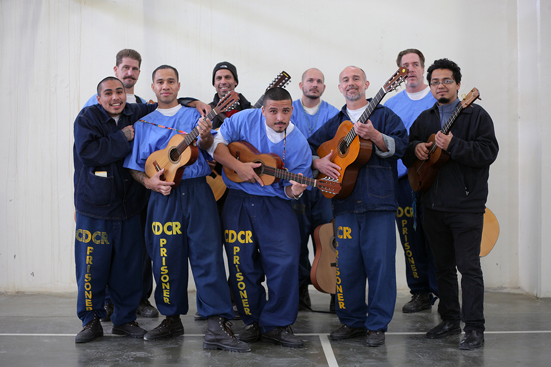This website uses cookies so that we can provide you with the best user experience possible. Cookie information is stored in your browser and performs functions such as recognising you when you return to our website and helping our team to understand which sections of the website you find most interesting and useful.

My co-instructor Cesar Castro and I were excited to bring these practices into a space so ripe with possibility. As we stood in front of our students for the first time, it was clear to me that we needed to make an immediate impact. Before handing out jaranas (small 8-string, 5-course guitar from the fandango son jarocho tradition) we performed a couple of sones for them. We began with El Cascabel which usually draws a positive response. Then we played La Bamba to drive the energy home. I must admit I was a little concerned because several participants were not Mexican and it is no secret that race wars are part of prison culture, but the feedback was nothing less than positive. For some people this was the first time they had held an instrument in their hands. Then we began teaching sones. To my surprise, everyone was cooperative and fully participating. As soon as everyone could navigate the basic three chords we began to play our first son, El Colas. This is an important moment, and I’ve seen it repeatedly during fandangos. Let’s call it “the realization of a sonic dialogue.” It’s not perfect or fluid. It doesn’t look or sound sexy. But at that moment, everyone’s voice offers an important contribution to the whole. Occasionally Cesar and I would demonstrate the music at full speed and volume. In one instance a participant expressed that he’d never been that close to live music and that it was a powerful experience. In another instance, a participant requested that we play another piece. We happily obliged as they sat attentively. When we were finished, the participant had tears in his eyes. He gave three solid claps and shouted, “THERAPY!!!”
After several weeks of focusing on fandango and the son jarocho, Cesar and I decided it was important to adjust our teaching according to the interests of the participants. Many of them owned guitars and showed a dedication to further developing their skills. We felt that Collective Songwriting would be a perfect way to challenge them technically while continuing to provoke thought about collective expression. I first learned the Collective Songwriting method in 1997 from former-nun-turned-radical singer/activist, Rosa Marta Zarate, in Chiapas, Mexico, for the Primer Encuentro Chicano Indigena Por La Humanidad Y Contra el Neoliberalismo. This encuentro consisted of a group of Chican@s convened with a group of Indigenous Rebels known as the Zapatistas. Our two communities spent several days discussing and relating, connecting each others’ struggles and triumphs. We then created works of art based on the discussions. The collective songwriting method relies upon broad participation, dialogue, testimony, and finally poetic and musical expression. Participants at Corcoran were very receptive to this process and demonstrated a consistent willingness to participate and more importantly to be vulnerable. In one particular session, the men chose to discuss the theme of love. When arriving at the point in the process where words and ideas become poetic phrases, there was a passionate dialogue about whether fears or tears come first in the sequence of emotional development in a relationship.
There was a time we used to say There was a time we used to say
Our love is strong, never fade away Our love is strong, never fade away
What we had was everlasting OR What we had was everlasting
Sharing hopes, fears Sharing hopes, tears
First came laughter then came tears First came laughter then came fears
After coming to a consensus about the lyrics, we began working out the melody and the music. Instantly, one participant assumed the role of the singer and began to improvise his way through the changes. I thought to myself, If only I had a camera or something to record this with. Then, I thought about it a little harder, and felt an even greater satisfaction knowing that this was our moment. However fleeting, it was something we collectively created by committing to one another and to hope. This was a community building moment that generated a sense of belonging for everyone involved. We played and sang the same song repeatedly for an hour.
In a separate session, due to administrative snafu, we ended up with only one student. This situation turned opportunity allowed us to spend concentrated time with one participant who responded magnificently. Using the Collective Songwriting method once again, we created a piece about his best friend, Miles, who had committed suicide a few months earlier. Much of the dialogue was about his memories of simpler times and being close to nature.
Early long mornings
Raining down
Another part of me
That’s being drown
Wash away
The night before
Driving through the woods
To a place the touches my core
Point St. George
Paddling for Miles
Through the channel
Of lost souls
These moments of connection were no accident and were experienced many times over the course of ten weeks. Convening methods like the ones we facilitated have been used for many years to create horizontal spaces for broad participation. Embedded in traditional arts practices are processes that lead us to community. In this way, traditional arts are not only outlets but vehicles that can afford the students spiritual, intellectual, and emotional mobility in an otherwise immobile environment. Each day I left the prison needing to make sense of my time spent with these men. Why was it so easy to connect? Each session seemingly created new connections. Each connection gave path to new possibilities. Each possibility, hope. Where there is hope, there is a sense of belonging. It is this sense of belonging that is so desperately needed for the well being of all humanity.

